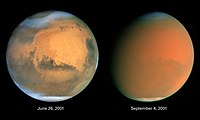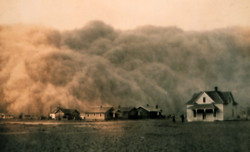Burza piaskowa

Burza piaskowa (burza pyłowo-piaskowa) to zjawisko atmosferyczne wywołane przez silne wiatry związane z wtargnięciem chłodnego powietrza polarnego na ciepłe obszary pustynne i półpustynne lub przez feny napotykające na swojej drodze luźny materiał skalny, zwietrzelinę, piasek i pył.
Burza piaskowa powstaje zazwyczaj wskutek konwekcji powietrza. Promienie Słońca rozgrzewają piasek, co powoduje podgrzanie mas powietrza znajdującego się bezpośrednio nad nim, co z kolei powoduje wzniesienie się gorącego powietrza, a ruch powietrza powoduje zmianę ciśnienia i powstanie silnego wiatru.
Największe z burz piaskowych sięgają do 2,5 km wysokości, niektóre z nich są widoczne z kosmosu.
Burze piaskowe lub pyłowe występują głównie na Wielkich Równinach w Ameryce Północnej, na Półwyspie Arabskim, pustyni Gobi w Mongolii, Saharze oraz innych pustynnych obszarach na świecie.
Burze piaskowe występują także na Marsie, na skalę znacznie większą niż na Ziemi. Niektóre z marsjańskich burz pokrywają nawet całą planetę i trwają nawet kilkaset dni.
Zobacz też
Media użyte na tej stronie
A massive dust storm cloud (haboob) is close to enveloping a military camp as it rolls over Al Asad, Iraq, just before nightfall on April 27, 2005. DoD photo by Corporal Alicia M. Garcia, U.S. Marine Corps. (Released)
Two dramatically different faces of our Red Planet neighbor appear in these comparison images showing how a global dust storm engulfed Mars with the onset of Martian spring in the Southern Hemisphere. When NASA's Hubble Space Telescope imaged Mars in June, the seeds of the storm were caught brewing in the giant Hellas Basin (oval at 4 o'clock position on disk) and in another storm at the northern polar cap.
When Hubble photographed Mars in early September, the storm had already been raging across the planet for nearly two months obscuring all surface features. The fine airborne dust blocks a significant amount of sunlight from reaching the Martian surface. Because the airborne dust is absorbing this sunlight, it heats the upper atmosphere. Seasonal global Mars dust storms have been observed from telescopes for over a century, but this is the biggest storm ever seen in the past several decades.
Mars looks gibbous in the right photograph because is it 26 million miles farther from Earth than in the left photo (though the pictures have been scaled to the same angular size), and our viewing angle has changed. The left picture was taken when Mars was near its closest approach to Earth for 2001 (an event called opposition); at that point the disk of Mars was fully illuminated as seen from Earth because Mars was exactly opposite the Sun.
Both images are in natural color, taken with Hubble's Wide Field Planetary Camera 2.





